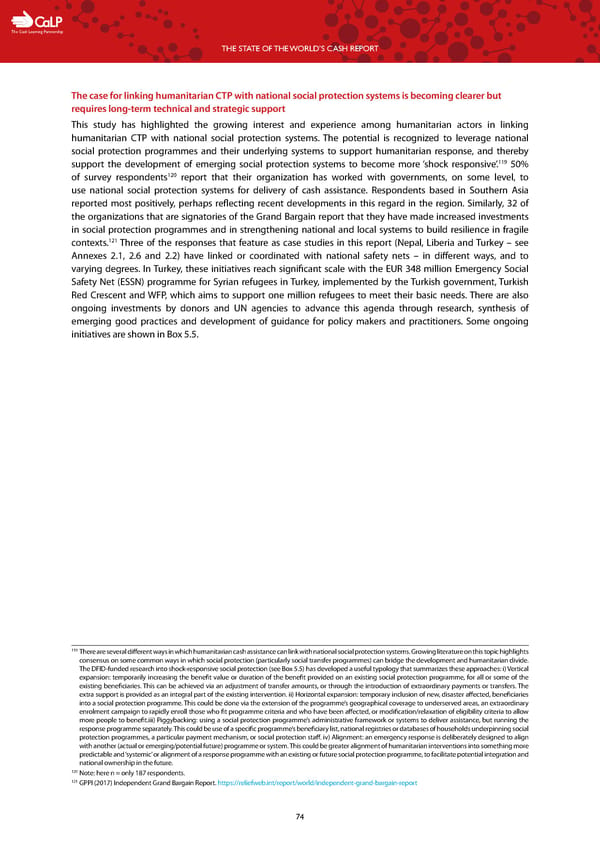C The Cash Learning Partnership THE STATE OF THE WORLD’S CASH REPORT The case for linking humanitarian CTP with national social protection systems is becoming clearer but requires long-term technical and strategic support This study has highlighted the growing interest and experience among humanitarian actors in linking humanitarian CTP with national social protection systems. The potential is recognized to leverage national social protection programmes and their underlying systems to support humanitarian response, and thereby 119 support the development of emerging social protection systems to become more ‘shock responsive’. 50% 120 of survey respondents report that their organization has worked with governments, on some level, to use national social protection systems for delivery of cash assistance. Respondents based in Southern Asia reported most positively, perhaps reflecting recent developments in this regard in the region. Similarly, 32 of the organizations that are signatories of the Grand Bargain report that they have made increased investments in social protection programmes and in strengthening national and local systems to build resilience in fragile 121 contexts. Three of the responses that feature as case studies in this report (Nepal, Liberia and Turkey – see Annexes 2.1, 2.6 and 2.2) have linked or coordinated with national safety nets – in different ways, and to varying degrees. In Turkey, these initiatives reach significant scale with the EUR 348 million Emergency Social Safety Net (ESSN) programme for Syrian refugees in Turkey, implemented by the Turkish government, Turkish Red Crescent and WFP, which aims to support one million refugees to meet their basic needs. There are also ongoing investments by donors and UN agencies to advance this agenda through research, synthesis of emerging good practices and development of guidance for policy makers and practitioners. Some ongoing initiatives are shown in Box 5.5. 119 There are several different ways in which humanitarian cash assistance can link with national social protection systems. Growing literature on this topic highlights consensus on some common ways in which social protection (particularly social transfer programmes) can bridge the development and humanitarian divide. The DFID-funded research into shock-responsive social protection (see Box 5.5) has developed a useful typology that summarizes these approaches: i) Vertical expansion: temporarily increasing the benefit value or duration of the benefit provided on an existing social protection programme, for all or some of the existing beneficiaries. This can be achieved via an adjustment of transfer amounts, or through the introduction of extraordinary payments or transfers. The extra support is provided as an integral part of the existing intervention. ii) Horizontal expansion: temporary inclusion of new, disaster affected, beneficiaries into a social protection programme. This could be done via the extension of the programme’s geographical coverage to underserved areas, an extraordinary enrolment campaign to rapidly enroll those who fit programme criteria and who have been affected, or modification/relaxation of eligibility criteria to allow more people to benefit.iii) Piggybacking: using a social protection programme’s administrative framework or systems to deliver assistance, but running the response programme separately. This could be use of a specific programme’s beneficiary list, national registries or databases of households underpinning social protection programmes, a particular payment mechanism, or social protection staff. iv) Alignment: an emergency response is deliberately designed to align with another (actual or emerging/potential future) programme or system. This could be greater alignment of humanitarian interventions into something more predictable and ‘systemic’ or alignment of a response programme with an existing or future social protection programme, to facilitate potential integration and national ownership in the future. 120 Note: here n = only 187 respondents. 121 GPPI (2017) Independent Grand Bargain Report. https://reliefweb.int/report/world/independent-grand-bargain-report 74
 The State of the World's Cash | Full Report Page 75 Page 77
The State of the World's Cash | Full Report Page 75 Page 77